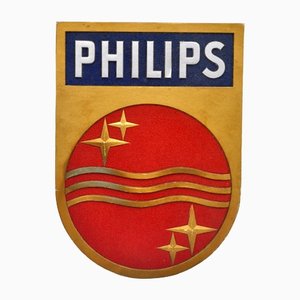
Dutch designer, art director, and architect Louis C. Kalff was born in Amsterdam in 1897. In 1916, he began architecture studies at the Technical University of Delft. As a student, he designed posters, banners, and costumes for school-related activities. In 1923, he interned for the architect D.F. Slothouwer. In December 1924, Kalff applied via letter to Anton Philips, president of Eindhoven-based light bulb and radio tube manufacturer Philips, asserting that the company’s advertising was not modern enough. On January 5, 1925, the 27-year-old Kalff joined Philips and was charged with the task of modernizing the company’s artistic and commercial advertising. In 1929, the Lighting Advisory Office (LIBU) was established under Kalff’s leadership to advise companies and architects in the field of lighting. In 1946, he was appointed Philips’ art director.
While at Philips, Kalff helped define the overall color, material, and form choices for a variety of projects. He also designed advertisements, branding, exhibitions, lighting, and various other products, including memorable pieces such as the curvy—as opposed to traditionally boxy—Chapel Radio (1931) and the Philips Philishave (1939); nicknamed “the cigar,” the latter was an electric shaver with a rotary system shaped like a Greek column with tapered sides. He also designed several architectural projects, including the Astronomical Observatory (1937, Eindhoven) and the spaceship-like Evoluon technology museum (1966, Eindhoven), which became a conference center in the 1990s. He also independently designed posters, book covers, as well as private homes and commercial buildings.
In 1958, Kalff initiated the Philips Pavilion at the Brussels World’s Fair. To demonstrate the company’s cutting-edge technology, he conceived a multimedia exhibition that featured an electronic poem (Le Poème Électronique) by Swiss architect Le Corbusier and music by French-American composer Edgard Varèse accompanied by a range of video and audio effects. Kalff retired in 1960, but remained active as a consultant and architect for Philips. He also lectured and, in 1941, wrote the book, Artificial Light and Architecture.
Kalff passed away in Waalre in 1976. In 2011, the Louis Kalff Instituut opened in the Regional Historical Center Eindhoven. It’s devoted to preserving and digitizing the archives of nationally important industrial designers for educational purposes.

